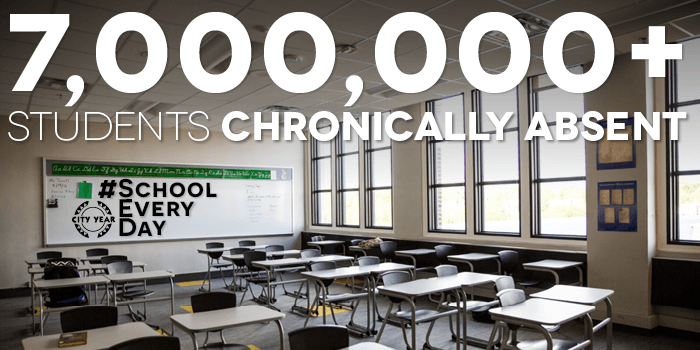Why City Year strives to ensure that students come to #SchoolEveryDay

Defining chronic absenteeism
A new report offers additional insights about a severe crisis affecting more than 7 million students across the country and impeding school improvement efforts: chronic absenteeism, defined as missing 15 or more days of school in a single year. Research shows that chronic absenteeism is an indicator that a student is in trouble academically and is at increased risk for dropping out of school and other negative lifetime outcomes.
According to Portraits of Change: Aligning School and Community Resources to Reduce Chronic Absence, an analysis of federal and state data by Attendance Works and the Everyone Graduates Center at Johns Hopkins University, nearly 10,000 U.S. public schools report that 30 percent of their students are chronically absent each year. Another 10,000 schools report that 20 to 29 percent of their students are chronically absent. The report also found that chronic absence levels are higher in schools that serve large percentages of low-income students.
We know that all students must be present and engaged in their learning if they are going to succeed, and that cultivating the habit of regular attendance is an important factor in college and career readiness. Consistent attendance helps students to develop the persistence, discipline and mindsets required for success in the 21st century workforce. Our City Year district and school partners across the country also recognize that efforts to improve instruction and classroom environment will fall short if students are not in school.
The new analysis explores troubling information on chronic absence that was released for the first time last year by the U.S. Department of Education Office for Civil Rights and underscored just how serious a problem this is. According to Chronic Absenteeism in the Nation’s Schools: An unprecedented look at a hidden educational crisis, 14 percent of America’s 50 million K-12 students, or one in seven students, were “chronically absent” in 2013-2014, though the numbers are even higher for students of color and English language learners — one in five of whom are chronically absent.
While the data show that chronic absence is a problem everywhere, it is also concentrated in some places. Just 4 percent of U.S. school districts, many of which serve our poorest neighborhoods, produce half of our nation’s chronically absent students. In many cities, more than 30 percent of students miss three or more weeks of school in a single year, including Boston, Columbus, Detroit, Philadelphia, Providence and Washington D.C. — all places served by City Year AmeriCorps members.
While these numbers are alarming, the report also points out that it is possible to reverse chronic absenteeism, particularly through effective cross-sector partnerships and a robust use of data to target where additional resources are needed to intervene.
Addressing chronic absenteeism and educational equity
City Year believes that when schools and partners work together, we can not only tackle chronic absenteeism but also ensure that all students–regardless of race, socio-economic status or zip code–have access to developmental relationships with caring adults who inspire them to come to school regularly, and receive appropriate academic and social-emotional supports that help them to flourish.
This new analysis, released during Attendance Awareness Month, inspires us to redouble our efforts as 3,100 City Year AmeriCorps members begin their service in 331 public schools this year, working alongside our partners to powerfully engage students and families and ensure that more students graduate from high school, ready for college, career and life.
City Year’s approach is grounded in data and research that shows students who exhibit one or more “early warning indicators” are at increased risk for dropping out of school: low attendance, poor behavior and course failure in English or math. Research shows that students who start the 10th grade without any of these early warning signs are three times more likely to graduate.
City Year’s dedicated AmeriCorps members serve in hundreds of our nation’s schools full-time, working in partnership with teachers to identify students who are off-track or at risk for falling off-track and collaborating on solutions to prevent or reduce early warning indicators. These solutions include reaching out to students and families who are frequently absent from school and welcoming students each day so they feel engaged and appreciated; providing one-on-one tutoring and coaching to students who have fallen behind; and facilitating afterschool programs and whole-school activities designed to enhance overall school culture and climate.
These interactions enable City Year AmeriCorps members to form developmental relationships with the students they serve as tutors, mentors and role models, and successfully deliver evidence-based academic and social-emotional supports that help students to thrive.
Our work is having an impact. In 2015, City Year AmeriCorps members helped to drive a 36 percent reduction in students who are chronically absent in middle and high schools we serve across the country. Additionally, a randomized control study of Diplomas Now–a school improvement partnership between City Year, Talent Development Secondary at Johns Hopkins University and Communities In Schools–demonstrated that the Diplomas Now partnership had a statistically significant impact on reducing chronic absenteeism in the middle grades, providing the highest level of evidence that it is possible to reduce chronic absenteeism even in the highest-need schools.
Improving attendance is just one — though very important — part of holistic efforts to transform schools into places of learning, exploration and risk taking, where every student feels safe and connected to his or her school community; where data is used continuously to help promote student growth and achievement; and where all students have access to positive and caring relationships, both with adults and other students, as well as personalized learning environments that encourage them to persevere through challenges and build on their strengths.
It is this transformation of how schools operate that City Year and our partners are working toward, every day.
Jim Balfanz is the CEO of City Year and continues to lead the evolution of the City Year model as a scalable, human talent strategy for high-need schools. His leadership has helped drive City Year’s research, impact and growth to over 3,100 AmeriCorps members serving more than 331 schools across 28 US cities.
Learn more about service with City Year:
Related stories
Every year, thousands of young people decide to join AmeriCorps programs for a year (or more!) of service, helping to...
Read more about Everything you need to know about returning for another year as a City Year AmeriCorps memberCity Year is committed to providing our AmeriCorps members with resources, opportunities and support that help them to achieve their...
Read more about Empowering Futures: City Year Baton Rouge’s Partnership with Bottom LineFatimah Abdulmateen takes service seriously. Fatimah served two years with City Year as an AmeriCorps member, making her an alum...
Read more about A City Year alum with a passion for service—both here and abroadThough this part of the City Year experience may be particularly challenging, it’s also normal! And we want you to...
Read more about The “mid-fall slump” in schools is real--here's what to expect















